
Albizia: planting, pruning and care
Contents
Albizia in a nutshell
- Albizia produces a distinctive flowering of silky, pinkish-white plumes
- Tolerant of drought and saline soils, it copes with poor soils and is fairly easy to grow
- A full-sun plant, best placed in a warm position
- With its exotic appeal, it brings a holiday feel to any garden!
- Valued for its superb, very finely divided foliage
- Perfect tree for providing shade!
A word from our Expert
Also called Silk tree or Mimosa of Constantinople, Albizia julibrissin is a deciduous tree with very finely divided foliage and silky flowering. Flowers are composed of a large number of very long stamens, pale pinkish-white in colour. They form pom-poms with a feathery, very soft appearance and are set off by soft green foliage. In addition, Albizia’s flowering is fragrant and melliferous!
Discover the superb variety Albizia julibrissin ‘Ombrella’, which has beautiful green leaves and pink flowering. There are also varieties with dark, purple foliage, such as ‘Summer Chocolate’… an unusual, richly nuanced colour!
Albizia is appreciated for its very beautiful spreading silhouette that provides dappled shade. We recommend planting it in spring, preferably as a specimen. Once established in the garden, it is easy to grow and requires very little maintenance. If you wish to prune it to give a harmonious shape, do so at the end of winter or in early spring. It is a plant that enjoys heat: perfect for southern gardens, it will thrive in full sun and in well-draining, even slightly sandy soil.
Botany
Botanical data
- Latin name Albizia julibrissin
- Family Fabaceae
- Common name Silk tree, Constantinople mimosa
- Flowering summer
- Height generally up to 6 metres
- Exposure full sun
- Soil type well-drained
- Hardiness between -5 and -15 °C, depending on variety and plant age
Albizias are deciduous trees and bushes valued for their silky inflorescences and very finely divided foliage, delicate like mimosa! The species most commonly cultivated is Albizia julibrissin. It is thought to originate from Persia (Iran) and parts of Asia (Asia Minor, Himalaya, Bhutan, China, Japan…). It has naturalised in several regions worldwide and has become an invasive young plant in the United States. The genus Albizia includes between 140 and 150 species native to Africa, Australia and Asia. They occur in tropical and subtropical regions, which explains Albizia’s preference for warm positions and its only moderate hardiness.
It was named Albizia in honour of Filippo degli Albizzi, a naturalist who introduced the plant to Europe in the 18th century. Its species name, julibrissin, would derive from Persian and mean “silk flower”. That idea is echoed in its vernacular name Silk tree, referring to its very soft, silky flowers. In French it is also called Mimosa de Constantinople, and it is indeed very close to mimosa. For its scientific name, it is sometimes placed in the genus Paraserianthes (synonym).
Albizia belongs to the family Fabaceae, like beans, peas, wisteria, clovers or lupin… It is one of the most economically important families, containing many food plants. These plants have the particularity of not needing nitrogen fertilisers, since their roots, by associating with bacteria, can fix atmospheric nitrogen. Albizia belongs to the subfamily Mimosoideae: it is very close to mimosas and acacias.
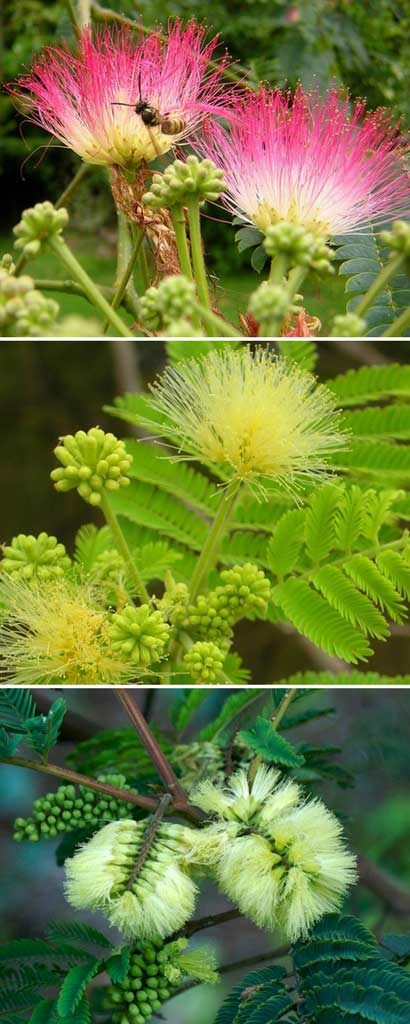
Albizia flowers
Albizia generally reaches between six and ten metres in height, but it can grow up to 15 metres in optimal conditions. Albizia has superb architecture: it takes a rather spreading habit, with very horizontal branches, allowing it to reach 5 to 6 metres in spread. With its flattened crown, it has an almost parasol habit… a perfect tree for shade! Its bark is grey, smooth, forming vertical striations as the tree ages.
Albizia flowers in midsummer, from mid-June–early July through to August–September. It then produces an original display, in tassels or pompom-like clusters, gathered in terminal clusters. Each flower is borne on a long peduncle (flower stalk), and measures between two and four centimetres in diameter. Flowers have very short, fused sepals and petals, in five lobes. It is the stamens, very long and numerous, that are striking. They measure between two and four centimetres in length and give that very soft appearance that earns the plant its Silk tree nickname. They are white at the base and bright pink at the tip, offering a distinctive, luminous gradient. Flowers are hermaphrodite (they bear both male and female organs: stamens and pistil). Depending on species, inflorescence shape may vary. For example, in Albizia lophantha it takes the form of a “bottlebrush”.
Flowers of Albizia julibrissin take the form of white and bright pink pompoms, which stand out nicely against green foliage. They resemble calliandra flowers. Depending on species and variety, flowers can also be entirely white, as in Albizia julibrissin ‘Alba’, or creamy white, as in Albizia amara, or yellow-green. Sometimes they take a very vivid, almost red hue, as in Albizia ‘Rouge de Tuilière’. When white or cream, Albizia flowers have a very light, delicate aspect.
Albizia flowers are fragrant! They produce nectar and are melliferous: they attract bees and butterflies.
Because Albizia is very close to mimosas and acacias, it also has very attractive foliage that resembles theirs. Its foliage is light, not very dense, providing dappled shade that shelters from sun while allowing good light penetration. Albizia is a deciduous tree, dropping its leaves in autumn and producing new ones in spring. Leaves of Albizia julibrissin can reach up to 45 centimetres long and up to 25 centimetres wide. They are alternate, arranged one after another along the branches.
Albizia foliage is extremely decorative. Leaves are twice-divided: they divide into leaflets, which themselves divide into leaflets… producing very small segments that make the foliage particularly light and feathery! Its very fine leaves somewhat resemble fern foliage. They are often composed of 8 to 12 pairs of leaflets, each redivided into 20 to 50 leafletlets. Number of leaflets and leafletlets varies by variety, but is always even: they are paripinnate. Leafletlets are oblong and measure up to one centimetre long.
Leaves have a very attractive colour, a tender yet deep green. Albizia ‘Summer Chocolate’ stands out for its very dark, brown-purple foliage. Young leaves are first green, then darken with age. This variety offers slightly less striking flowering than Albizia ‘Ombrella’, but is spectacular for its foliage!

Albizia foliage: detail of an Albizia julibrissin leaf / purple foliage of Albizia ‘Summer Chocolate’ / Albizia julibrissin (photo Jean-Pol GRANDMONT)
Leaflets have the particularity of being able to move: they fold at night and when light is low. Do not forget that Albizia is very close to mimosa, including Mimosa pudica, a sensitive plant known for folding its leaves very quickly when touched… Fabaceae easily fold their leaflets!
Albizia roots, like those of other Fabaceae, can fix atmospheric nitrogen by associating with bacteria of the genus Rhizobium. Roots form nodosities that allow bacteria to live in sym symbiosis with the plant, supplying nitrogen in exchange for carbon compounds from photosynthesis.
From September–October, Albizia produces long flattened pods, first green then brown. They measure between 10 and 20 centimetres long and contain between five and fifteen oval, dark brown seeds. Albizia can self-seed. You can harvest seeds and store them for sowing in spring.

Detail of Albizia julibrissin pods (photo Ninjatacoshell) / pods still on tree / seeds contained in pods (photo Ninjatacoshell)
Albizia is not extremely hardy. It can withstand -10 °C, even -15 °C for short periods if cold does not persist. Be vigilant with young plants, which are more sensitive to cold, and do not hesitate to use fleece protection. Albizia grows quite rapidly, especially in a warm sunny climate, but does not live very long, rarely exceeding 25 or 30 years.
What are the main varieties of Albizia?
Most popular varieties
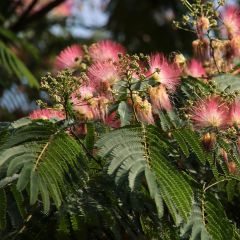
Albizia julibrissin Ombrella
- Flowering time August, September
- Height at maturity 5 m
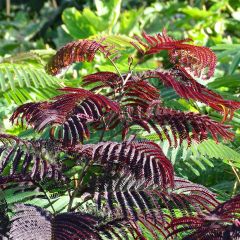
Albizzia julibrissin Summer Chocolate
- Flowering time August, September
- Height at maturity 4,50 m
Discover other Albizia
View all →Available in 2 sizes
Available in 1 sizes
Available in 2 sizes
Available in 1 sizes
Available in 1 sizes
Available in 1 sizes
Available in 1 sizes
Available in 1 sizes
Available in 1 sizes
Available in 2 sizes
When to plant Albizia?
Where to plant?
It is preferable to grow Albizia in a mild climate. It will be ideal in gardens of southern France! During first years it is relatively sensitive to cold. Once mature, it copes better with cold winters and can tolerate between -10°C and -15°C. In any case, plant in full sun, in a warm, well-exposed situation. Choose a site sheltered from cold winds. Albizia ‘Summer Chocolate’ seems a little more fragile and delicate to grow than variety ‘Ombrella’.
Albizia is an undemanding plant that tolerates poor soils. It thrives in a free-draining, rather sandy soil. Avoid planting in clay soil. It really dislikes stagnant moisture and overly compacted soils. Do not hesitate to add draining materials at planting: pumice, gravel…
Albizia tolerates salty soils well: it will adapt easily to coastal gardens. It also tolerates calcareous soils.
As Albizia can become quite large, it is best not to plant it too close to a house or a terrace. Its roots spread and sometimes produce suckers, which could damage the building. In any case, it is better to give it enough space to develop its crown freely, without needing severe pruning.
If you live in a region with a harsh climate, prefer to grow Albizia in a container (at least for the first years) and bring it into a greenhouse for winter. Choose a large pot and place a drainage layer at the bottom. Plant the tree and water. You can eventually plant it in ground after a few years.
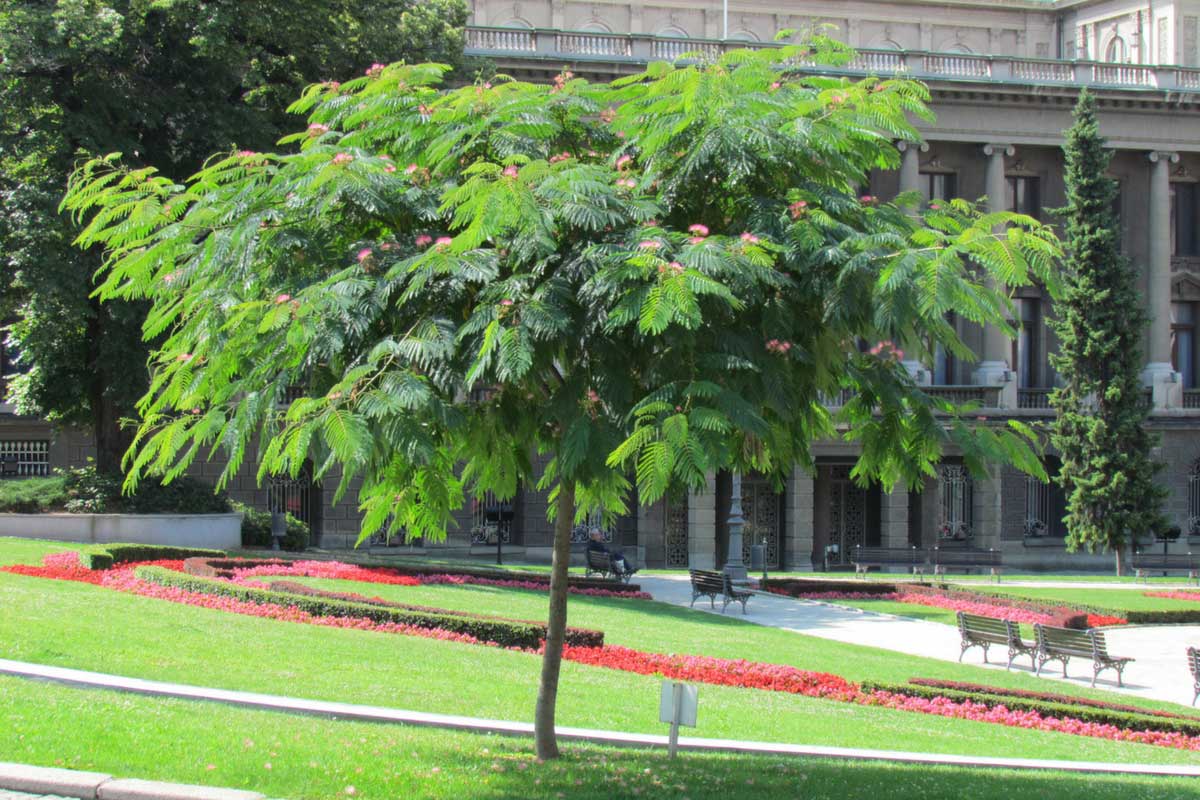
We recommend planting Albizia in full sun and as a specimen plant! (photo Mihailo Grbic)
When to plant?
Plant Albizia preferably in spring, avoiding frosty periods.
How to plant Albizia?
It is generally recommended to plant Albizia as a specimen, to better showcase it. However, if planting several, leave at least seven metres between trees.
- Place the rootball in a tub of water to soak. This will aid plant establishment.
- Dig a planting hole two to three times the size of the rootball (at least 80 cm wide and deep). Do not hesitate to add gravel or pumice to improve drainage.
- Remove the plant from its pot and gently tease out the roots.
- Place your Albizia. The top of the rootball should be level with the soil.
- Insert a stake to keep the trunk upright.
- Backfill with soil and firm down.
- Water thoroughly.
We recommend regular watering in the weeks following planting.
Read also
Albizia: when and how to prune?How to care for Albizia?
Albizia is drought-tolerant. It is preferable to water it during year of planting, but once established, it will easily do without watering. During early years, tree is still fragile, so we recommend protecting it for winter with a winter fleece. You can also lay mulch around base of tree: this will provide extra protection against cold and help keep soil cool. Albizia is suited to poor soils and has fairly low needs for fertiliser or compost. You can still apply a little in early spring to encourage flowering.
Pruning Albizia is not always necessary. If you do wish to intervene, follow our advice: Albizia: when and how to prune it? For an old specimen, read our article How to rejuvenate an old Albizia or bristle tree.
As for diseases, Albizia can be affected by fusarium wilt, caused by a fungus. Leaves wilt and discolour, but tend to remain on tree. As with many fungal diseases, it is favoured by combination of heat and humidity. Unfortunately there is no treatment. Cut and burn affected branches to prevent spread.
Albizia is sometimes affected by coral disease. Bark becomes deformed and cracks, and orange pustules appear on trunk and branches. If tree is severely affected, we recommend felling it to prevent disease spreading to other plants. Otherwise, cut and burn affected twigs, apply a wound-sealing mastic then spray a fungicidal treatment (Bordeaux mixture, sulphur…). Feel free to consult our advice sheet: How to prevent coral disease?
Also watch out for canker. These are fungi or bacterium that attack wood: branches dry out, bark cracks, callus formations appear on trunk or branches… We recommend removing damaged parts and applying a fungicidal treatment (Bordeaux mixture, sulphur…). As prevention, to avoid canker, make clean pruning cuts with disinfected tools and apply a wound-sealing mastic.
Psyllids can attack Albizia. These are insects that pierce foliage and secrete honeydew. This can drip beneath tree, staining anything underneath (cars, garden furniture…). Sometimes scale insects attack Albizia. Honeydew secreted by psyllids or scale insects can lead to sooty mould (a black substance caused by a fungus) covering foliage. To control psyllids and scale insects, spray foliage with black soap. When grown under glass, Albizia can also be attacked by red spider mites.
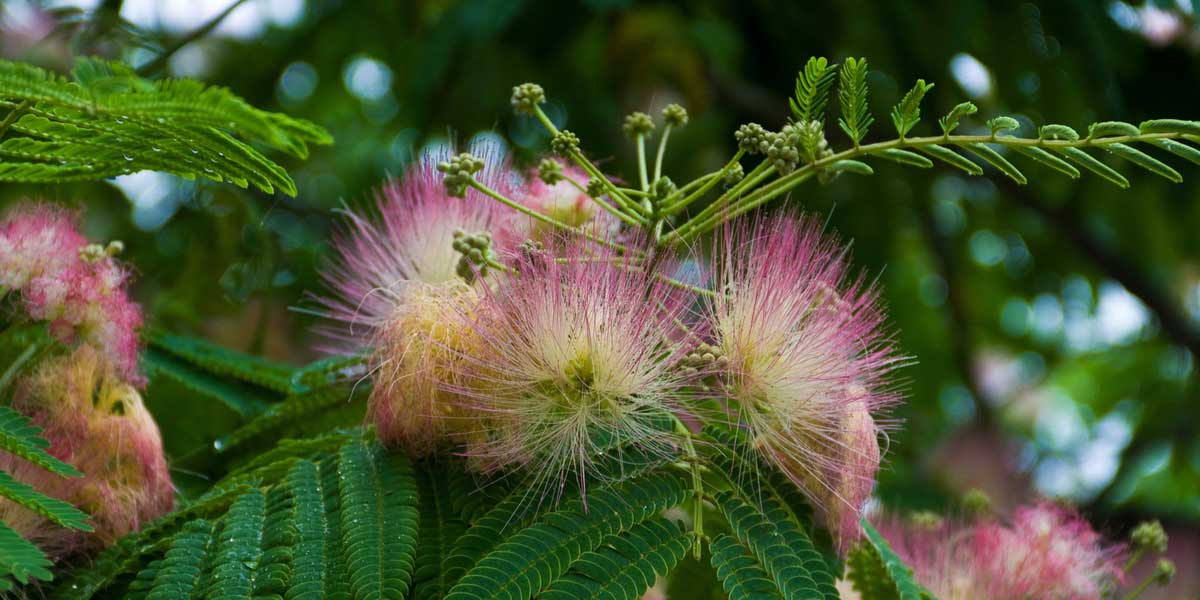
How to propagate Albizia?
To propagate Albizia, we recommend sowing, which is easier to succeed than propagation by cuttings or grafting.
Sowing Albizia
Prefer sowing seeds of botanical species Albizia julibrissin rather than seeds of varieties ‘Ombrella’ or ‘Summer Chocolate’, as latter may produce young plants different from original variety. Sow in late winter or early spring.
- If you already have an Albizia in garden, harvest seeds from tree, in pods, once pods have turned brown and dry. Otherwise, you can order them.
- Store seeds until early spring in cool, dry place.
- Before sowing, place seeds in warm water for at least 24 hours. This softens seed coat. You can also scarify seeds to aid germination by nicking coat with knife or using sandpaper.
- Fill pots with potting compost mixed with sand, then water.
- Sow seeds, then cover with layer of compost (two to three centimetres thick) and firm lightly.
- Place pots in warm, sheltered position (at least 18 °C), with good light.
- Substrate should remain fairly cool until germination. Water regularly.
- Pot on into individual pots when young plants are large enough to handle. You can grow them under cover first year and plant in garden following spring.
Sometimes Albizia self-seeds and you may see small shoots at base of tree. Simply lift them and pot on.
More information in our tutorial How to sow Albizia to obtain beautiful young plants?
Propagating Albizia by cuttings
In midsummer, you can take semi-ripe cuttings. Propagation by cuttings is more delicate to succeed than sowing, but allows faithful reproduction of horticultural varieties.
- Prepare a pot by filling with potting compost.
- Take a shoot at least 10 centimetres long. Cut just below a node (point where leaf attaches to stem). There must be no flowers on this branch. Also remove leaves from base of stem, keeping only those at top of cutting.
- Optionally dip base of cutting in rooting hormone.
- Insert cutting into substrate and firm compost around stem.
- We recommend placing a plastic bag over pot to create humid atmosphere.
- Place pot in sheltered, bright spot, but out of direct sun.
- Open plastic bag regularly to ventilate and prevent fungal growth.
- Water as soon as substrate begins to dry.
Root cuttings can also be taken in winter, around February. Scrape soil around tree to recover some roots (2 to 3 centimetres in diameter). Cut fragments at least 10 centimetres long. Prepare pots with compost and plant roots in them. Water.
→ Learn more in our tutorial Take a cutting from Albizia
Grafting Albizia
You can graft Albizia in summer by shield budding. Water rootstock and budwood a few days before performing graft.
- Cut a branch from variety you wish to propagate.
- Remove a well-formed bud by incising bark over a few centimetres, avoiding taking wood (harder part at centre of branch).
- Make T-shaped cut on rootstock by carefully incising bark.
- Place bud in rootstock incision and trim edges if they protrude.
- Tie graft union leaving bud exposed. Bud should begin to develop following spring.
How to combine Albizia with other plants?
Albizia is ideal when planted in isolation. It has a magnificent silhouette, with branches that grow horizontally giving it a very spreading habit. We recommend placing it in middle of a short grass meadow, possibly with garden furniture beneath (bench, table, sun lounger…), to enjoy a relaxing moment in dappled shade.
You can also plant it in a row. Planted along a path, it will provide attractive shade and a majestic touch. You can alternate Albizia varieties, for example by pairing varieties with pink flowers with others that have white flowers… Or by pairing green foliage of the Albizia ‘Ombrella’ with purple foliage of variety ‘Summer Chocolate’. You will achieve a lovely contrast.
To pair with Albizia, we recommend choosing other plants in similar tones. Prefer large, divided foliage, such as wisteria or ferns, to create a lush-looking garden. Also opt for flowering in pink or mauve tones: Gaura lindheimeri, oleander, Lagerstroemia indica…
For an exotic feel, Albizia can also be paired with other plants of an exotic character. Choose, for example, castor oil plant, Trachycarpus palms or Phormium. In all cases, choose plants that prefer warm, dry conditions. You can create a Mediterranean-inspired garden by planting lavender, Jerusalem sage (Phlomis fruticosa), santolinas or Gaura lindheimeri (its flowering will complement Albizia!). Also favour climbing plants, which you can train over a pergola or against a wall: trumpet vine, wisteria, grapevine and bougainvilleas. Create a dry garden with luxuriant, refreshing foliage and colourful flowering.
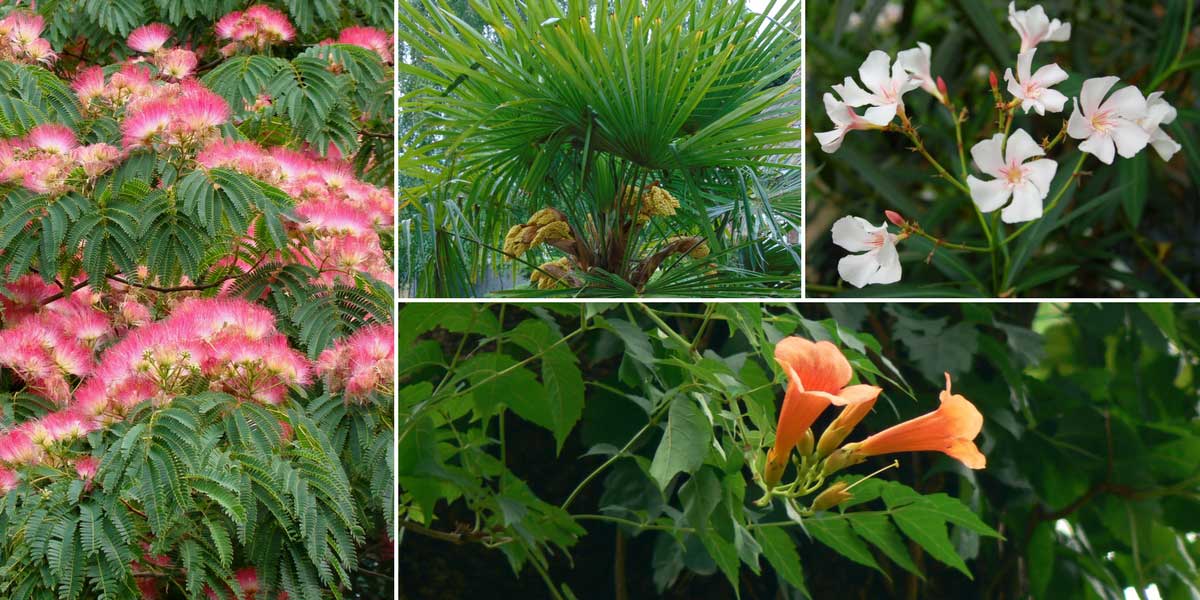
Albizia can find its place in an exotic-style garden! Albizia julibrissin ‘Ombrella’ (photo wlcutler), Trachycarpus fortunei, Nerium oleander (photo Tubifex), Campsis radicans (photo Dinesh Valke)
→ Discover other ideas to pair with Albizia in our article!
Did you know?
- Uses
Albizia wood can be used in joinery and cabinetmaking. Its bark is used in Chinese medicine for its diuretic, digestive and anti-inflammatory properties. Its flowers can also be used to treat depression, insomnia and anxiety.
Useful resources
-
- Discover our Albizia varieties
- Take inspiration from this exotic ambience to pair Albizias
- Discover our article on Albizia diseases and parasitic pests
- Article – How to prevent coral disease
- Article : trees that do well in full south-facing exposure
- Article : trees with an umbrella habit
- Our articles on Albizia :
- How to choose an Albizia?,
- 7 Albizias to plant almost anywhere in France
- Our tutorials :
Frequently asked questions
-
C’est très probablement du miellat, sécrétion collante produite par des insectes piqueurs-suceurs (pucerons, cochenilles, aleurodes/“whitefly”, psylles…). Le miellat favorise ensuite le développement de la fumagine (moisissure noire) qui salit et gêne la photosynthèse. Voici quoi faire, étape par étape :1) Identification rapide - Retournez quelques feuilles : cherchez petits insectes verts/noirs ou masses blanches cireuses le long des nervures et sur les rameaux. - Si vous voyez des fourmis très actives, elles « élèvent » souvent pucerons/cochenilles pour récupérer le miellat.2) Nettoyage initial - Rincez abondamment le feuillage à l’eau claire (jet doux) pour enlever le miellat et la fumagine superficielle. - Pour taches tenaces, utilisez une solution d’eau savonneuse douce (quelques gouttes de savon noir/liquide vaisselle dans 1 litre d’eau), puis rincez.3) Traitement des parasites (options selon intensité) - Légère infestation : pulvérisez savon insecticide (insecticidal soap) ou huile de Neem matin ou soir (éviter plein soleil). Répétez tous les 7–10 jours jusqu’à disparition. - Cochenilles ou infestations localisées : gratter délicatement les cochenilles adultes et traiter avec huile horticole ou savon. - Forte infestation sur arbre de grande taille : traitement systémique (par ex. produits à base d’imidaclopride ou autre produit professionnel) — à faire par un professionnel arboricole si l’arbre est grand ; respecter étiquettes et période floraison pour protéger pollinisateurs.4) Méthodes biologiques et préventives - Favorisez auxiliaires : coccinelles, syrphes, larves de chrysopes. Évitez traitement systémique pendant floraison. - Contrôlez les fourmis (pièges ou bandes collantes sur le tronc) pour casser la relation fourmi–puceron. - Taillez branches très atteintes pour réduire source d’infestation et améliorer circulation d’air.5) Après nettoyage - La fumagine s’estompe après élimination du miellat ; si tâches noires persistent, nettoyez doucement. - Surveiller régulièrement et intervenir tôt.6) Quand demander un professionnel - Si l’arbre est grand et traitement nécessite injection/travail en hauteur, ou problème récurrent malgré traitements, faites appel à un arboriculteur agréé.Si vous voulez, envoyez une photo des feuilles (face supérieure et inférieure et du rameau) — je vous dirai exactement quel parasite suspecter et quelle solution privilégier.
This is honeydew secreted by psyllids, small insects that pierce leaves to feed on sap. You may also see sooty mould develop on the foliage (black substance on leaves, caused by a fungus). We recommend treating with black soap or pyrethrum.
-
My Albizia's leaves have blackened. Why?
They are probably covered in sooty mould, a fungus that develops on honeydew secreted by psyllids or scale insects. There is not really any danger to the plant, but it is nevertheless weakened and its photosynthesis is limited. Treat for psyllids or scale insects using black soap.
-
Bark on my Albizia is splitting and peeling, and twigs are drying out... What should I do?
Your tree is probably affected by coral disease. It can also be recognised by presence of orange pustules on bark. Cut affected parts, then destroy them by burning. If tree is severely affected, consider felling it to prevent disease spreading to other plants. Feel free to consult our advice sheet: How to prevent coral disease?
If bark is damaged and you see swellings appearing on trunk or branches, it is likely a canker, a disease caused by a bacterium or a fungus that attacks wood. Cut affected branches and apply Bordeaux mixture or sulphur. As a preventive measure, to avoid both coral disease and canker, carry out clean, neat pruning with disinfected tools and then apply wound-sealing paste.
-
Leaves wilt and turn yellow!
Your Albizia is affected by fusarium wilt, a fungal disease causing yellowing of leaves that generally remain attached to twigs. Unfortunately, there is no treatment for this disease. We recommend cutting and burning the affected branches.
If leaves wilt and fall, it may also be suffering from lack of water, especially if you planted it recently. But overall, Albizia is a fairly hardy plant: unless planted within the past year or during a prolonged drought, it can easily go without watering.
- Subscribe!
- Contents
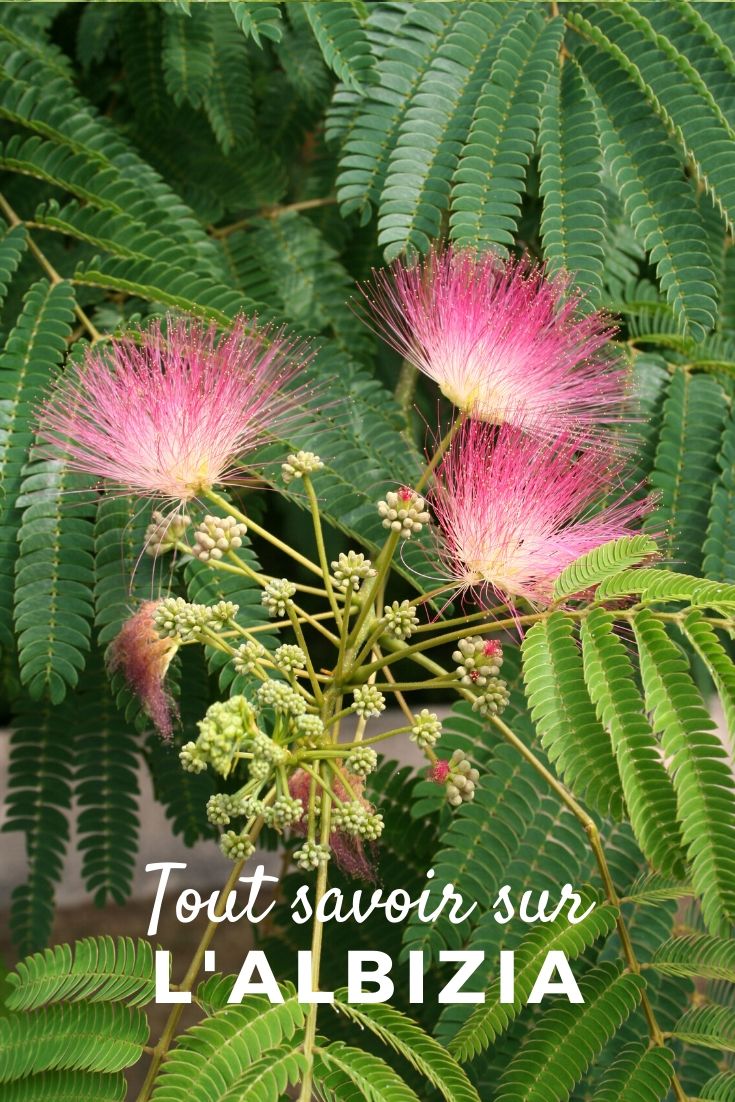


































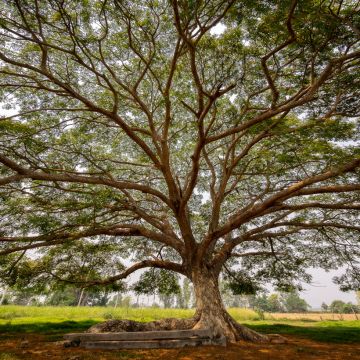
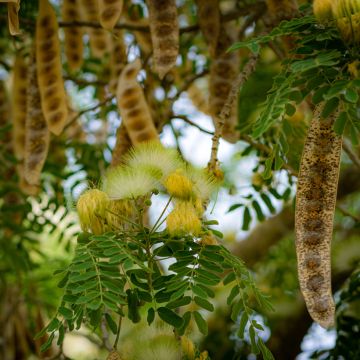
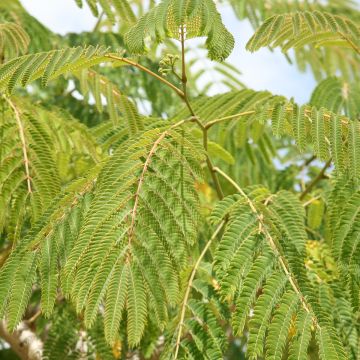
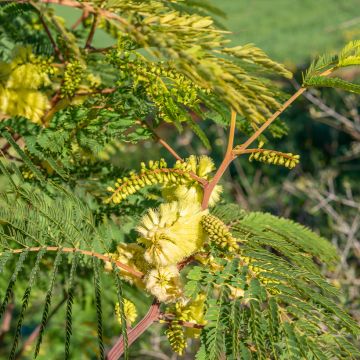
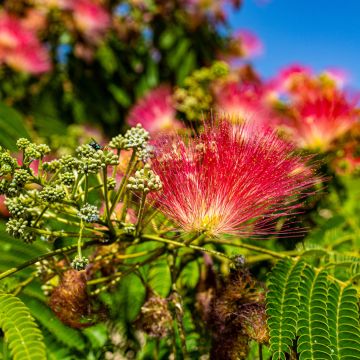
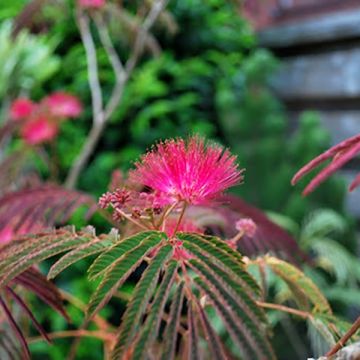
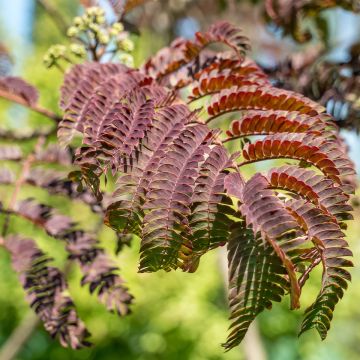
Comments